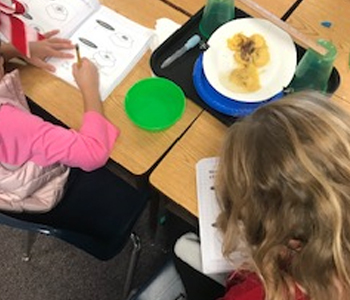Getting Good at Getting Better
By Krista Bernsten
As schools attempt to improve their practice in the Next Generation Science Standards (NGSS), Vista Unified School District has engaged in NGSS site walkthroughs using a classroom observation tool developed with the K-12 Alliance as a part of the CA NGSS K-8 Early Implementation Initiative. Over the past five years, teachers and administrators in the district have participated in a variety of NGSS professional learning events. During that time, administrators had the opportunity to see NGSS in action by observing a few of their designated teachers leaders during lesson studies. However, there had been no mechanism for administrators to really reflect on the extent of school-wide NGSS implementation at their own sites, or to receive personalized support. From this need, sprung the idea of the NGSS site walkthroughs. The purpose of the walkthroughs is to support the NGSS implementation at each site by giving specific feedback to support administrators in implementing next steps in teacher professional learning.

a walkthrough.
The walkthrough tool features three rubrics to address the major shifts required by NGSS: phenomena-based instruction, three dimensional sensemaking, and student-to-student discourse. For each NGSS walkthrough, we meet as a team. This typically includes a site teacher leader, the principal and a member of the NGSS Core Leadership Team (our district science leadership team). We discuss each site’s NGSS implementation and area of focus from the rubric. From there, we visit classrooms, noting the evidence from student work and learning for that NGSS shift. The rubric allows for discourse and focused conversation between the team during the walkthrough. The team then reflects what was happening in classrooms. The discussion begins with celebrations, then moves to trends across the campus and ends with a plan for deeper learning and implementation of the NGSS shifts. The team then engages in a conversation about the area of focus on the walkthrough observation tool. The outcomes of those discussions guide planning of next steps and professional learning for each site.
The walkthrough observations and feedback are critical in catalyzing change in the classrooms. In our second year walking classrooms with the tool, teachers are building proficiency by expanding their lens from discourse to questioning. At my site, Lake Elementary, we shared the observation tool with teachers prior to the walkthroughs. Being transparent about what the observation team would look for made teachers more comfortable with the walkthroughs, feedback, and reflection. We call this “getting good at getting better.” This year we implemented lesson study cycles using the observation walkthrough tool. Teachers collaborate, plan, observe, evaluate student work, and reflect on lessons. They use this cycle to improve science instruction in the classroom and build confidence in implementing the NGSS.
The walkthroughs provide valuable trend data district-wide. Across the district, we found many sites needed professional learning around crosscutting concepts, questioning, and opportunities for discourse. We found science notebooks being used across the district, but saw that a student work protocol would be useful to focus on evidence of student understanding of and teaching three dimensionally. Investigations before explanations, and the need for phenomena that connects student understanding to real world experiences and explanations, were also areas of need that rose to the surface. As a member of our NGSS Core Leadership Team, I am able to communicate these trends and needs to other district administrators, and help influence the strategic plan to support NGSS implementation across the district.
Krista Berntsen is an elementary principal at Lake Elementary in Vista Unified School District. She serves on the core leadership team with the CA NGSS K-8 Early Implementation Initiative and is a member of CSTA.






